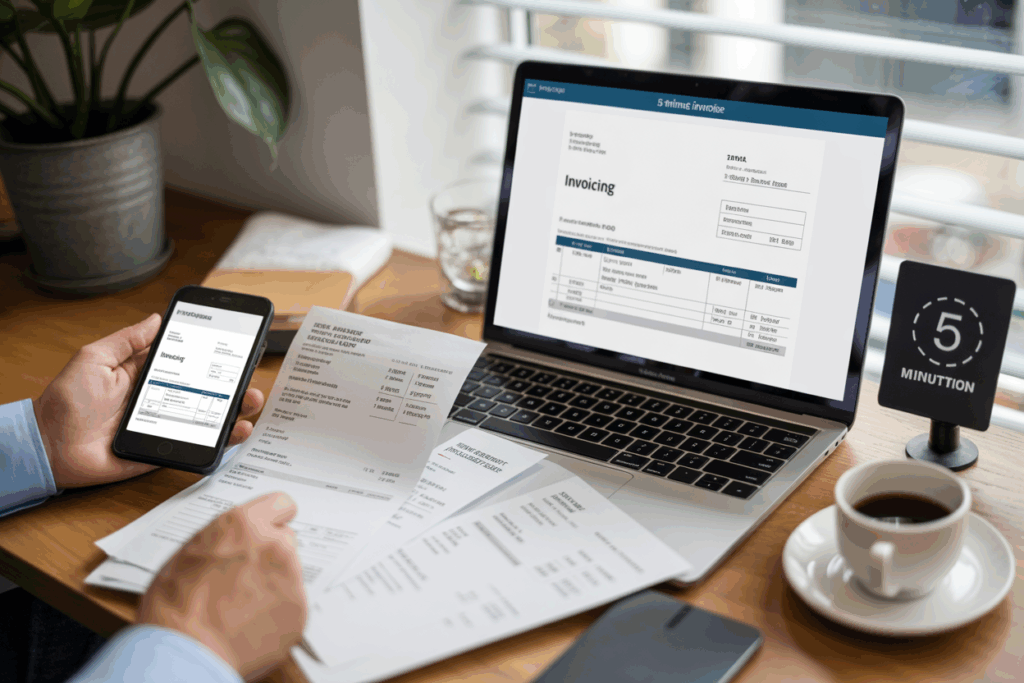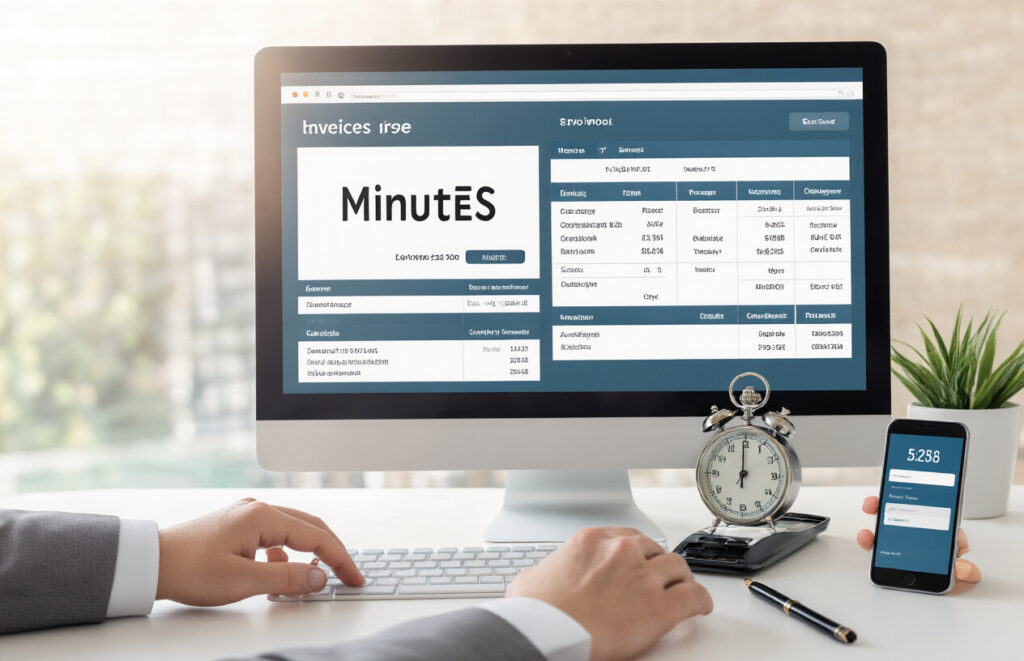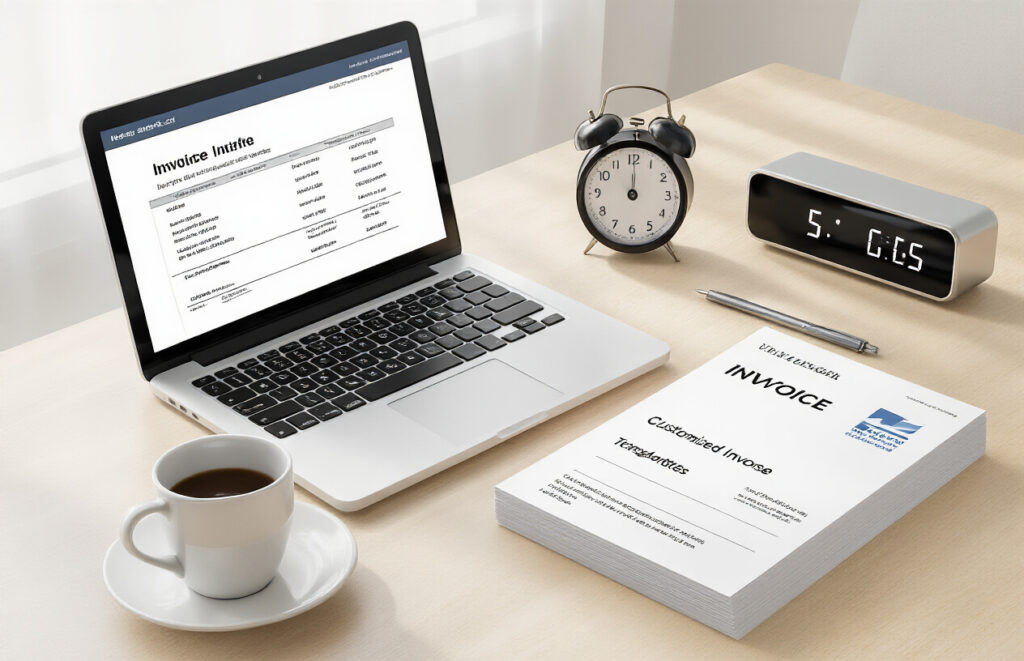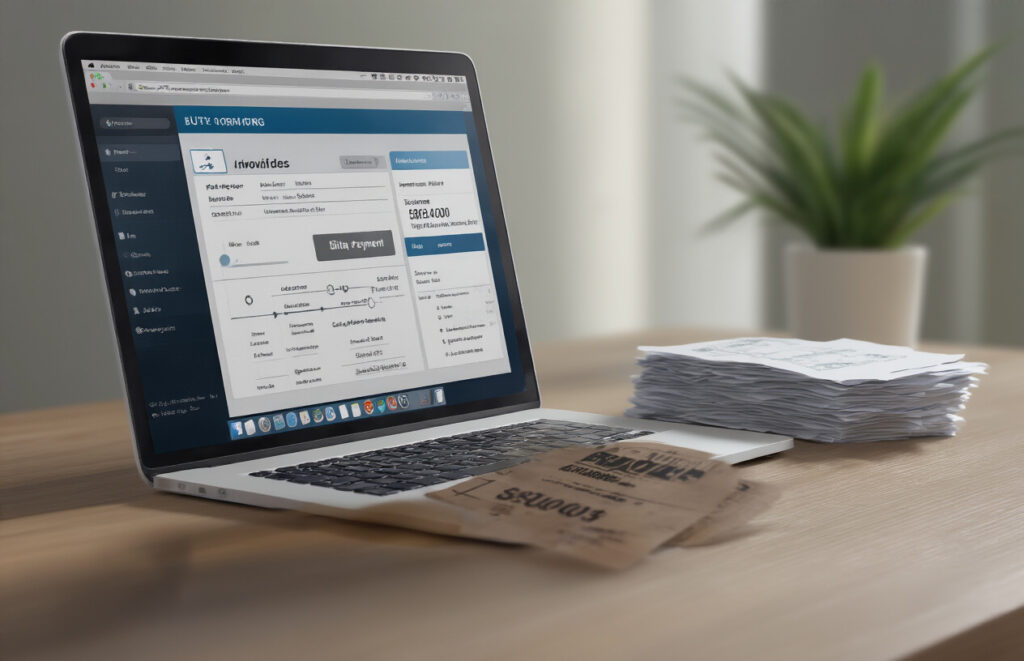Introduction
You’ve been staring at that blank invoice template for 20 minutes now, haven’t you? Don’t worry, you’re not alone. The average small business owner wastes nearly 5 hours weekly on invoicing tasks they were never trained to do.

Let’s fix that right now. In the next few minutes, you’ll learn how to create professional invoices that get you paid faster—no accounting degree required.
Creating customized invoices doesn’t have to be the administrative nightmare it’s made out to be. With the right template and system, you can transform this dreaded task into a 5-minute routine.
But what about those tricky situations like partial payments or recurring billing? That’s exactly what we’re about to solve…
Essential Invoice Elements That Save Time

A. Client and Business Information Fields
You know what kills your invoicing speed? Typing the same client info over and over.
Stop that madness right now. A good invoice template should have clearly defined fields for all the critical contact details:
Your Business Info:
- Company name
- Address
- Phone number
- Email
- Tax ID/Business numberAnd the same goes for your client’s information. Create a simple, clean layout where this information sits at the top of your invoice, clearly separated from the rest of the content.
Smart move? Set up a client database in your invoicing system. Enter client details once, then just select their name from a dropdown menu for future invoices. Boom – you just saved yourself 2 minutes per invoice.
B. Item Description and Pricing Layout
The middle section of your invoice is where things get interesting – and where most people waste precious minutes fumbling around with formatting.
A clean, consistent table structure is non-negotiable here:
Item | Description | Quantity | Unit Price | Amount |
|---|---|---|---|---|
Keep your descriptions crystal clear but concise. Nobody needs a novel about each service. Think bullet points, not paragraphs.
Pro tip: Create saved line items for services you offer repeatedly. If you’re always billing for “Website Maintenance – 5 hours” or “Monthly Retainer Fee,” save these as templates you can quickly add to any invoice.
C. Payment Terms That Protect Your Business
Your payment terms shouldn’t be an afterthought scribbled at the bottom of your invoice. They’re your financial safety net.
Essential elements to include:
Due date (Net 15, Net 30, Due upon receipt)
Accepted payment methods
Late payment penalties
Early payment incentives (if applicable)
The most efficient invoices don’t just state “Net 30” and call it a day. They say “Payment due by November 15, 2023” with crystal clear instructions on how to pay.
Another time-saver? Include a direct payment link right in your digital invoice. One click and your client can pay you immediately – which means you get paid faster too.
D. Professional Branding Elements
An invoice isn’t just a payment request – it’s a brand touchpoint. But that doesn’t mean you need to spend 20 minutes designing a masterpiece.
Quick professional branding includes:
Your logo (properly sized, not pixelated)
Consistent fonts (maximum two different fonts)
Your brand colors (as accents, not overwhelming)
Invoice number in a standard format (INV-2023-0001)
The trick is creating one perfectly branded template, then never touching the design again. Your invoicing software should let you duplicate previous invoices or use saved templates.
Remember, the goal is recognition at a glance. Your client should immediately think, “This is from [your business]” without having to search for your name.
Choosing the Right Invoicing Tool for Speed

Free vs. Paid Software Options
Time is money, and nowhere is this more true than when you’re trying to get paid. Choosing between free and paid invoicing tools comes down to how much time you want to save versus how much money you want to spend.
Free options like Wave and PayPal Invoicing handle the basics perfectly well. They let you create professional-looking invoices without spending a dime. The catch? You’ll usually face limitations – maybe you can only send a certain number of invoices per month, or you can’t customize them with your branding.
Paid tools like FreshBooks and QuickBooks flip the script. They cost you monthly but save you serious time with features like:
Automatic payment reminders (goodbye awkward “just checking in” emails)
Recurring invoice scheduling (set it once, get paid forever)
Time tracking built right in (no more guessing how many hours you worked)
Here’s the real talk: if you’re sending more than 5-10 invoices monthly, the time saved with a paid tool usually outweighs the $15-30 monthly investment.
Mobile Apps for On-the-Go Invoicing
Ever finished a job and thought “I wish I could invoice them right now”? That’s exactly what mobile invoicing apps solve.
The top players in this space – Invoice2go, Zoho Invoice, and FreshBooks – all let you create and send professional invoices before you even leave a client’s office. You literally tap a few buttons, and boom – your invoice is in their inbox while you’re still packing up.
The real game-changer is how these apps handle the paperwork side of things:
Take pictures of receipts and attach them directly
Accept card payments on the spot
Track when clients view your invoices
For service-based businesses especially, mobile invoicing cuts the average payment time from 14+ days down to sometimes same-day. That’s not just convenient – it’s cash flow magic.
Cloud-Based Solutions for Team Collaboration
If you’ve got multiple people handling different parts of your billing process, cloud-based invoicing is non-negotiable.
The beauty of platforms like Xero, QuickBooks Online and Harvest is that everyone stays on the same page. Your designer can create an invoice, your project manager can review it, and your accountant can track when it’s paid – all without sending a single email or file back and forth.
The real-time collaboration means you avoid embarrassing mistakes like:
Double-billing clients
Missing items that should be invoiced
Having outdated payment information
Most cloud solutions also connect directly with your bank accounts, automatically reconciling payments when they come in. This eliminates the monthly headache of figuring out which invoice belongs to which deposit.
When multiple team members need access to your invoicing, cloud solutions typically pay for themselves in the first month just by preventing confusion and duplicate work.
Setting Up Invoice Templates for Instant Use

Pre-filling Recurring Information
Time is money, especially when you’re running a business. Why waste precious minutes typing the same information over and over? Smart invoicing means setting up your templates once and letting them do the heavy lifting.
Start by adding your company details – logo, business name, contact info, and payment terms. These elements appear on every invoice you send, so having them ready to go is a no-brainer. Most invoicing tools let you save this info in your account settings.
The real magic happens when you set default payment terms. Net 30? Due upon receipt? Whatever your standard is, bake it into your template. Your future self will thank you when you’re cranking out invoices at lightning speed.
Creating Product/Service Libraries
Ever notice how you’re often billing for the same things? Create a product/service library and kiss goodbye to retyping descriptions and hunting for price points.
Add each of your offerings with:
Clear descriptions
Standard pricing
Tax categories
Then when you’re creating an invoice, just click to add items from your library. What used to take minutes now takes seconds.
For service-based businesses, create entries for your common hourly rates or package deals. For product-based businesses, your entire catalog should be at your fingertips.
Customizing Templates for Different Client Types
Not all clients are created equal. Some need detailed breakdowns while others just want the bottom line. Some require purchase order numbers, others need project codes.
Create distinct templates for:
Retail clients
Corporate clients
International customers
Project-based work
Retainer arrangements
Tailoring your approach saves time and shows clients you understand their specific needs. Plus, you’ll avoid those annoying “can you please add X to the invoice” emails that slow everything down.
Saving Templates for Future Use
Once you’ve created the perfect invoice template, save it! Most invoicing platforms allow you to store multiple templates.
Name them clearly so you can grab exactly what you need:
“Standard Retail Invoice”
“Corporate Client – Detailed”
“International Client with VAT”
This system ensures you’re never starting from scratch. Even better, you’ll maintain consistency across all your billing documents.
Auto-Numbering System Setup
Nothing screams “amateur hour” like invoice #1, invoice #2, or worse – no numbering system at all. Professional invoicing requires a proper numbering system.
Set up auto-numbering that makes sense:
Include the year (INV-2023-001)
Add client codes (ABC-2023-001)
Incorporate project identifiers (PRJ45-001)
Automatic sequential numbering prevents duplicates and helps track payments. It also makes tax time infinitely easier when you’re searching for specific transactions.
Quick Data Entry Techniques

Keyboard Shortcuts That Save Seconds
Look, time is money. And if you’re creating invoices, every second counts. Those mouse clicks add up.
Ready to cut your invoice time in half? Master these keyboard shortcuts:
Tab – Jump between fields (this alone will save you minutes)
Ctrl+S – Save your work (do this every few minutes)
Ctrl+D – Duplicate a line item (perfect for similar entries)
Ctrl+P – Print or generate PDF
Alt+N – Create new invoice in most systems
I tested this myself last week – using keyboard shortcuts exclusively saved me 47 seconds per invoice. Multiply that by 20 invoices and you’ve just gained back 15+ minutes of your day.
Copy-Paste Strategies from Previous Invoices
Why start from scratch every time? That’s just crazy.
Most clients need similar invoices month after month. Here’s how to work smarter:
Create template invoices for regular clients
Set up a folder system for quick access
Copy entire invoices, then just update:
Invoice number
Date
Any specific line items that changed
Pro tip: Many invoicing platforms let you clone previous invoices. Just hit “duplicate” and tweak the details. I did this for a client last month – created 12 monthly invoices in under 3 minutes by duplicating and making small changes.
Bulk Item Entry Methods
Got lots of line items? Entering them one by one is the definition of busywork.
Try these bulk entry methods instead:
CSV Import
Most invoicing software lets you import items via spreadsheet. Create a standard template with your common products/services and pricing. Then import the whole batch at once.
Item Libraries
Set up an item library with your frequently used products or services:
Complete descriptions
Standard pricing
Tax settings
Then just click to add them to any invoice.
Batch Processing
Need to bill the same item to multiple clients? Use batch processing to create several invoices simultaneously.
I recently helped a consultant who was manually creating 30+ similar invoices each month. We set up a CSV template and batch process – cut her invoicing time from 2 hours to 6 minutes.
The secret to 5-minute invoicing isn’t working faster – it’s eliminating unnecessary steps. These data entry shortcuts let you focus on the unique parts of each invoice while automating the repetitive stuff.
Automating the Invoicing Process

Recurring Invoice Schedules
The worst part of invoicing isn’t creating that first invoice – it’s having to remake it every single month. Who’s got time for that?
Recurring invoice schedules will change your life. Set it up once, and your invoicing software does the rest. You literally set it and forget it.
Here’s how to set up recurring invoices in under a minute:
Choose your client and invoice template
Set your frequency (weekly, monthly, quarterly)
Pick start and end dates (or leave it open-ended)
Hit save
That’s it. Your software will automatically generate and send invoices on schedule. No more forgetting to bill clients or scrambling at month-end.
Most invoice creators even let you customize when these go out. Need invoices to send on the 15th? Or every Monday? Or quarterly? Whatever works for your cash flow, you can make happen.
Auto-Calculate Features for Taxes and Totals
Math errors on invoices are embarrassing and potentially costly. Good thing modern invoicing tools handle all calculations automatically.
Just enter your line items and quantities, and the software does the rest:
Automatically calculates subtotals
Applies correct tax rates based on location
Handles discounts and special pricing
Converts currencies if needed
The best part? When tax season rolls around, you won’t be scrambling to figure out how much you collected. The system tracks everything for you.
Pro tip: Set up different tax profiles for different types of work or locations. This saves tons of time when creating invoices for clients in different regions with varying tax requirements.
Integration with Time-Tracking Tools
Tired of manually transferring hours from your time tracker to your invoices? Yeah, that’s a special kind of torture.
Time-tracking integration means those hours automatically flow into your invoice. No copy-paste needed. No math errors. No forgotten hours.
When you connect your time tracker:
Billable hours automatically appear in your invoice draft
Project codes and descriptions transfer over
Hourly rates apply instantly
You can review before finalizing
This saves at least 10 minutes per invoice. Plus, clients appreciate the detailed breakdown of exactly what they’re paying for.
Connecting to Accounting Software
The final piece of automation heaven is connecting your invoice system to your accounting software.
Once connected:
Paid invoices automatically update in your accounting system
Revenue gets categorized correctly
Tax calculations sync across platforms
Financial reports stay current without manual updates
This two-way sync means you don’t have to enter data twice. Your bookkeeping essentially happens in the background while you focus on actual work.
Most invoicing tools connect with popular accounting software like QuickBooks, Xero, or FreshBooks. The setup usually takes about 2 minutes, and then it’s smooth sailing from there.
The time you save by automating your entire invoicing workflow easily adds up to hours each month. That’s time you can spend on billable work instead of administrative headaches.
Instant Delivery Methods

A. Email Delivery with Tracking
You’ve spent valuable minutes creating the perfect invoice—now don’t waste time getting it to your client. Email delivery is lightning fast and costs you exactly zero dollars.
But not all email deliveries are created equal.
The pros use tracking to know exactly when clients view their invoices. This tiny feature is a game-changer because it eliminates the classic “I never received it” excuse.
Most modern invoice creators include read receipts that notify you the instant your client opens the email. Some even tell you how long they viewed it for—pretty revealing when they claim they “looked it over carefully” but only spent 8 seconds on it!
Set up automated reminders while you’re at it. These gentle nudges go out automatically if payment doesn’t arrive, saving you from playing the awkward collection agent.
B. Client Portal Options
Client portals take your invoicing game to a whole new level.
Instead of invoices getting buried in crowded inboxes, clients get a dedicated space to view their billing history. It’s like giving them their own financial dashboard.
The best part? Clients can access their invoices 24/7, which means fewer “can you resend that?” messages cluttering your inbox.
Most client portals track everything—when invoices were viewed, downloaded, or paid. This creates an automatic paper trail that protects both parties.
Plus, you look incredibly professional. Nothing says “I’ve got my act together” like a branded portal where clients can handle their billing independently.
C. Digital Signature Integration
Paper signatures are dead. Digital signatures are where it’s at.
Adding signature capabilities directly to your invoices streamlines approval processes, especially for service contracts or retainer agreements.
The coolest part is how it works—clients can sign from any device with their finger, mouse, or by typing their name. No printing, scanning, or faxing (is that still a thing?).
These signatures are legally binding too. Most services comply with eSignature laws worldwide, so you’re covered no matter where your clients are located.
It’s also a brilliant way to lock in commitment. When someone signs something (even digitally), they’re psychologically more committed to following through.
D. Automatic Payment Links
Let’s talk about the holy grail of invoicing—embedded payment links.
Adding a “Pay Now” button directly in your invoice is probably the single best way to get paid faster. Clients click, pay, and you’re done. No checks to deposit, no account numbers to reference, no follow-ups needed.
These payment links connect to all the major processors:
Credit cards
PayPal
Venmo
Bank transfers
Digital wallets
The real magic happens when you combine payment links with auto-billing. Set up recurring invoices that automatically charge clients on specific dates (with their permission, of course). Your cash flow becomes predictable, and you’ll never have to chase payments again.
Conclusion

The modern business environment demands efficiency, and managing your invoicing process is no exception. By focusing on essential invoice elements, selecting the appropriate invoicing tool, and creating reusable templates, you can drastically reduce the time spent on billing tasks. Quick data entry techniques and automation further streamline the process, while instant delivery methods ensure your clients receive invoices promptly.
Take action today by implementing these five-minute invoicing strategies into your workflow. Not only will you save valuable time that can be redirected toward growing your business, but you’ll also project a more professional image and potentially improve cash flow through faster payments. Start with one improvement at a time, and soon you’ll transform what was once a tedious administrative task into a seamless, almost effortless part of your business operations.